Making a floor shine is the bread and butter of a housekeeper or maid and when you personally clean your house, almost a quarter of the time is spent on cleaning the floor. You may be engaging a professional cleaner for floor cleaning maybe once a quarter but it’s a daily ritual in most households. There is good reason why you should invest in the right tools for the job and have the right information at hand to accomplish this task.
Here we have put together a comprehensive professional floor cleaning guide which will answer all your questions about floor care and the do’s and don’ts. You can also check out our article 10 Best Picks for your DIY Professional floor cleaning kit for cleaning the floor like a pro.
General Floor Care
Let’s first go through the general drill of cleaning the floor.
- Sweep or vacuum the floor. You can use a broom or vacuum cleaner of choice.
- If there are any tough stains which you would like to tackle before mopping, click here to jump to the section below.
- Once you are satisfied with the stains, you can go ahead with the mopping.
- Add the prescribed quantity of floor cleaner like Taski R2 or Lizol/Domex cleaner to the mop bucket.
- Insert the mop head into the handle, dip in the mop bucket and wring out the excess water.

How to tackle hard stains on floor

Baking soda or cif are useful in tackling hard floor stains. If you want an eco friendly way of cleaning your floor stains, baking soda is your best bet. Strong abrasive chemicals like Cif can also be used for stubborn stains like rust.
- Apply a generous portion of Cif or Baking soda on the stain and leave for 15-30 minutes. Do this after you sweep/vacuum your floor and before mopping.
- Use a scrubber, either manual or power scrubber for dislodging the dirt or stains. A hard toothbrush can also come handy, especially when dealing with tile joints.
- Once done wipe off dry with a rag or microfiber cloth.
How to clean vitrified tiles
Vitrified tiles are probably the easiest to maintain, they are highly durable, non-porous and glossy. The glossy finish acts as a barrier for stains, dirt or oil resulting in a long life, easy to maintain floor. They are also resistant to chemicals, so unlike marble or granite they are not discolored when they come in contact with acidic stuff like lemons.
In case of stains use a concentrate cleaner. Otherwise the cleaning is pretty straightforward as detailed above in the General Floor Care section.
How to clean marble and granite floors
Marble and granite floors give your home an elegant, natural look which cannot be matched by artificial tiles. With this elegance comes a maintenance overhead, you need to take special care of the floor on a regular basis.
If you spill anything on a marble and granite floor, be sure to clean it up as immediately as possible. This is because marble and granite are naturally porous and any delay may permanently stain the floor. Items of acidic nature like lemons or tamarind or most citrus fruit juices which are common in Indian households, are the most problematic.
If you spill any acidic item, immediately mop it with a marble cleaner. Do not use a dish-washing liquid or strong floor cleaners which are generally acidic in nature. You can sprinkle baking soda and gently wipe it off.
Step by step procedure to clean a marble floor
- Use a specialized marble/granite cleaner instead of the regular floor cleaners. Ensure it is pH neutral.
- Use a carpet or mat to protect the marble floor.
- Use a marble sealer for long life and easy care.
- Do not put items like pots or metal decorative items directly on a marble floor as they may permanently stain the floor.

How to clean wooden floors
Wooden floors sits between marble and vitrified tiles in terms of ease of cleaning and maintenance. Water is a wooden floors biggest enemy, use water sparingly or else you would end up bloating your floor. Most wooden floors come with a heavy duty sealant which gives it shine, water resistance and protects the wood. Though a laminated wooden floor is water proof, water can get in between cracks or joints resulting in permanent damage or warping. You are safe as long as you use a mild cleaner and wring your mops tightly before mopping.

Step by step procedure to clean wooden floors
- Don’t mop with a dripping mop or excessive water
- Do dry mop immediately to allow the floor to dry quickly
- Dirt can be abrasive and scratch the coating, broom/vacuum regularly and use good doormats to prevent dirt entry
- Don’t drag furniture or other heavy items on a wooden floor, you will scratch the surface which may allow water to seep in
General Dos & Donts of Floor Cleaning
DOS
- Always broom or vacuum clean before mopping
- Mop the floor in an 8-pattern as explained above
- Always use a dry mop or microfiber mop to clean up any residual water or chemical
DONTS
- Don’t use a new cleaning chemical without testing on a small patch
- Don’t use a strong acid or acidic cleaner, most floors don’t respond well to acidic chemicals
- Don’t allow stains to permanently dye your floors, cleaning them off immediately reduces headaches later





